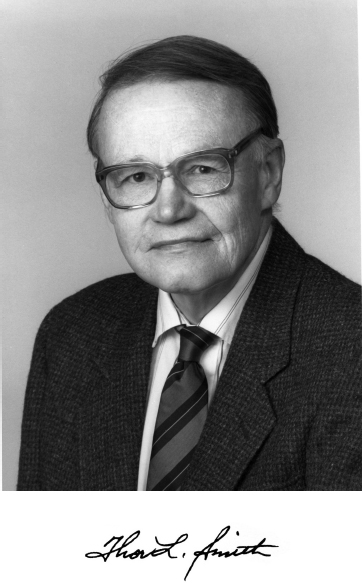1920–1999
Elected in 1990
“For pioneering studies of the basic engineering properties of elastomers and glassy polymers.”
BY DONALD R. PAUL
THOR L. SMITH, a well-known polymer scientist and retiree from IBM Almaden Research Center, died on September 6, 1999, at age 79 in Los Altos, California.
Thor was born June 11, 1920, in Zion, Illinois, where he grew up. He attended Wheaton College and received a BS in chemistry in 1942; he obtained an MS in physical chemistry from the Illinois Institute of Technology in 1944. He then went to the University of Wisconsin, where he worked under John D. Ferry and in 1948 received a PhD in physical chemistry specializing in polymers. His industrial career began immediately thereafter.
He first worked for Hercules Inc., in Wilmington, Delaware (1948–1954). In 1954 he moved to California, where he joined the Jet Propulsion Laboratory and did extensive research on solid rocket propellants, elastomers, rheology, and viscoelasticity. He served as a section chief (1956–1959) and then worked at the Stanford Research Institute (SRI) until 1968. He was named an SRI Fellow in 1964. He took a brief excursion into academia at Texas A&M University as professor of chemistry in 1968.
Thor returned to California in 1969 and began his career in the IBM Research Division. He worked in the Polymer Sciences and Technology Department until his retirement in 1990. He was involved in basic research in polymer science and
made a considerable impact in IBM technology in the areas of plastics and elastomer materials. He continued his interests in viscoelastic properties, rheology, strength, and toughness of elastomers and other filled materials. Later in his career he did important work in the area of glassy polymers.
Thor’s significant and lasting contributions to the literature on polymers have affected how these materials are incorporated into products. Some of the underlying principles from his work have been included in textbooks on polymers and become part of the essential fabric of the field.
Mechanical behavior was a central theme throughout his career. His early work focused on rubbery polymers and key issues related to their use in solid propellants for rocket motors. This led to the clever elucidation of the now famous “failure envelope” of rubbery materials and involved recognizing the applicability to failure behavior of time-temperature superposition principles from linear viscoelasticity.
His later work on the glassy state of polymers focused on their response to mechanical stress, motivated by issues related to the use of polymers in electronics and magnetic storage of information; but, again, basic principles emerged that influenced the field in more general ways. Specifically, he showed that mechanical stress affects molecular packing and mobility in the glassy state. One significant consequence of this is that the rate of sorption or permeation of small molecules such as water or gases is increased. Another consequence is that stress accelerates the rate of physical aging of glasses (i.e., their slow approach to a thermodynamic equilibrium state). These phenomena are factors affecting the stability and reliability of magnetic tapes for information storage and must be appreciated for high-performance systems.
In every case, Thor’s research was conducted with characteristic thoroughness and keen insight. Corresponding excellence is found in his more than 80 research publications in highly respected journals in the field. They have been widely read and used and some are regarded as classics.
Thor was active in numerous professional organizations including the American Chemical Society (Rubber, Polymer
Chemistry, and Polymer Materials: Science and Engineering Divisions), American Physical Society (fellow), Society of Plastics Engineers (SPE), and British Society of Rheology. He served as president (1967–1969) and vice president (1965–1967) of the Society of Rheology. He chaired the Gordon Research Conference on Elastomers in 1968 and the Winter Gordon Research Conference on Polymers in 1980. He served as a member of the board of trustees of Gordon Research Conferences (1978–1984) and chair in 1982.
He was a member of the NRC’s Evaluation Panel for the Polymers Division of the National Bureau of Standards (1974–1977) and National Materials Advisory Board Committees on Adhesion of Rubber to Steel (1971–1972) and on Science Base for Materials Processing (1978–1980). He chaired the Joint Army-Navy–Air Force Panel on the Physical Properties of Solid Propellants (1959–1961).
Thor received the prestigious Bingham Medal of the Society of Rheology in 1978 and the SPE Research Award in 1983. He received an Outstanding Innovation Award from IBM in 1978. He gave numerous invited lectures, including the G. Stafford Whitby Memorial Lectures at the University of Akron in 1974. He served on the editorial advisory boards of the Journal of Polymer Science: Polymer Physics Edition and Polymer Engineering and Sciences.
Thor Smith was a real gentleman who upheld high personal and professional standards with great dignity. He was highly respected by colleagues in the polymer field.
At the time of his death he was survived by his wife, Darlene Smith, and sons Theodore Lowe Smith and Glen E. Smith.





